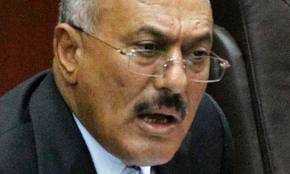 President Ali Abdullah Saleh of Yemen suffered injuries far more extensive than previously known in an attack on his presidential palace last week, with burns over 40 percent of his body, Yemeni officials and Western diplomats said Tuesday.
President Ali Abdullah Saleh of Yemen suffered injuries far more extensive than previously known in an attack on his presidential palace last week, with burns over 40 percent of his body, Yemeni officials and Western diplomats said Tuesday.
It was initially reported that Mr. Saleh, who is in the Armed Forces Hospital in Riyadh, had suffered burns on his face, neck and arms. when a blast struck at the palace mosque during prayers.
But the burns also covered some of his back as well, according to the sources, speaking on condition of anonymity.
“His face was quite charred,” said a Western official, speaking anonymously according to governmental rules. “The burns are serious; he is not as well as his aides are portraying it.”
The source of the explosion, which killed several guards and the imam of the mosque and injured several other government officials, has also been mysterious. It was initially believed to have come from a mortar or rocket attack from outside the compound.
But as the investigation continued, opinion has shifted to the possibility of at least one or more explosive devices, including in the minbar, or pulpit, a Western official said.
The explosive material also apparently contained some kind of accelerant that spurred flames, a Western diplomat said. Mr. Saleh was said to be bowing at the time the explosion erupted. “He was very close and that is why he was burned,” said the Western official.
The burns are not life-threatening, both the Yemeni and Western officials said. Given the pain involved with burns, however, the president would require strong sedation, the officials said.
The burns are expected to heal, but are extensive enough to need three or four months for that, said the Yemeni official, pointing to an extended absence.
There have also been reports that one of the wooden shards that sliced into his body punctured a lung, said Abdul Rahman al-Rashed, the head of the Arabiya television network. That too could require a more extended convalescent period, he said.
The minbar is usually a raised wooden platform from which the cleric delivers the Friday sermon — and the wooden shrapnel from it injured many senior figures including the president.
An aide reached at the hospital refused to confirm nor deny the extent of the president’s injuries.
Interpretations of Mr. Saleh’s medical state have varied according to the competing demands of the camps that would like different outcomes in Yemen.
Those who would like to see him return to power, including the vice president and aides with him in the hospital in Riyadh, portray him as in fine mettle and expected to return to Sana, the capital, any day. Those who would like to see him step down, whether in Yemen or outside the country, portray his condition as more dire.
Mr. Saleh was flown to Riyadh on Saturday with about a dozen of his top political allies who are all being treated at the Armed Forces Hospital.
Nouman Duweid, the governor of Sana, flown out a day later, remains in a coma, said Tareq Shami, the spokesman for the General People’s Congress. Other officials evacuated were the prime minister, the speaker of Parliament, the head of the Shura council, and two deputy prime ministers, including one, Sadiq Ameen Abu Ras, who lost a leg, Yemeni officials said.
At least a half dozen other members of parliament, advisers and soldiers are also being treated.
Leave a Reply
You must be logged in to post a comment.